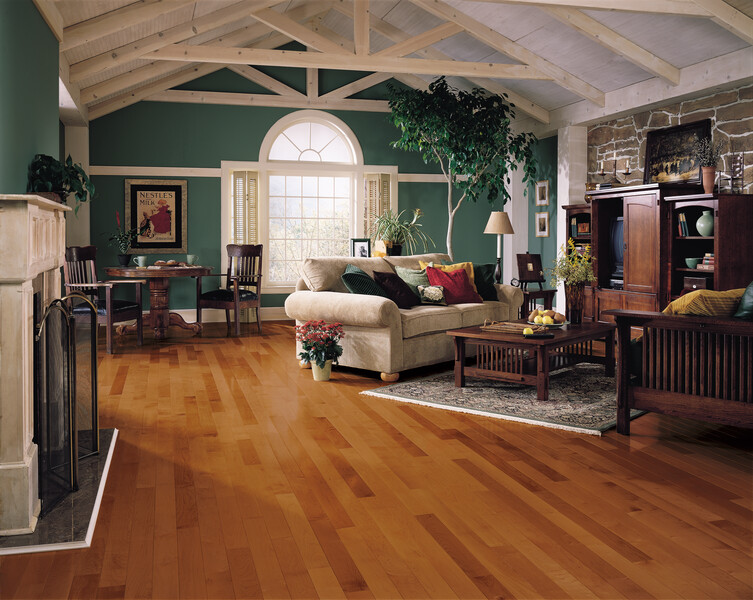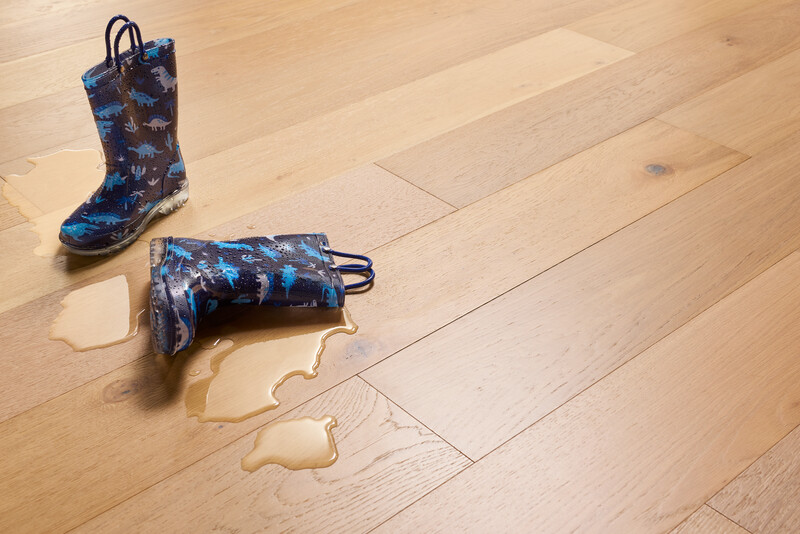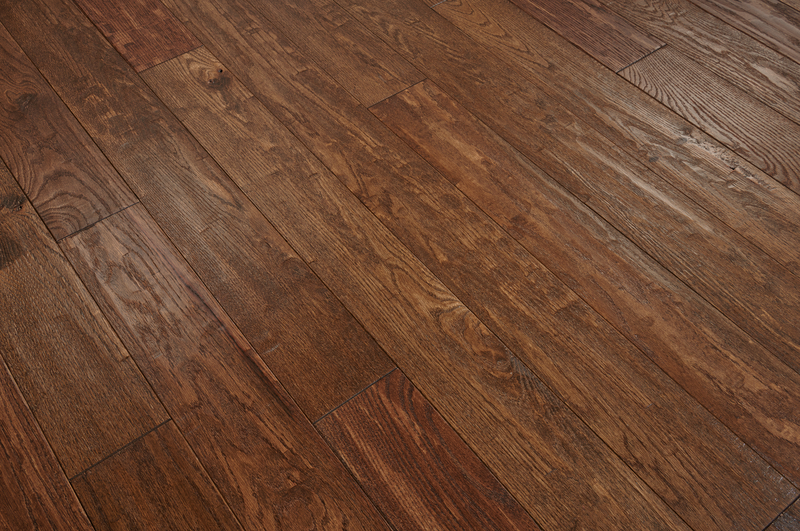How to Design a Space Around Hardwood Flooring
February 5, 2025

The flooring you choose is more than just a surface to walk on. It creates the foundation of your entire space. Floors are one of the first design elements people notice. They set the tone for everything in a room, from furniture to decor.
With its timeless beauty, natural warmth, and unmatched versatility, hardwood flooring has always been a popular choice for homeowners. Whether designing a cozy nook or a sleek, modern home, hardwood is a classic choice.
So, how do you use hardwoods as the foundation for your room design?
Using Hardwood as Your Foundation
Think of your hardwood flooring as your room’s largest piece of furniture. The color, grain, and finish of your wood flooring influence everything from wall colors to furniture choices. Your floors set the mood for the entire space.
For example, light woods like white oak create bright, open spaces perfect for modern homes. Darker woods bring richness and drama, ideal for traditional or rustic designs.
Textures like hand-scraped or wire-brushed finishes add depth and character to your floors. These features make real wood floors stand out, creating a natural and inviting atmosphere. You create a base that ties all design elements together by starting with your floors.
Choosing Your Perfect Floor for Your Design
Aesthetics and style are only part of the equation when designing your room. Your flooring selection needs to be as practical as it is beautiful.
Different areas of your home have unique demands. High-traffic entryways, moisture-prone bathrooms, or temperature-fluctuating basements all require different considerations. Choosing the right hardwood flooring means balancing design with functionality.
Fortunately, there’s a perfect hardwood option for every space in your home. Let’s discuss how these choices combine beauty and practicality to meet your home’s needs.
Solid Hardwood
Solid hardwood floors offer timeless appeal with their thick, real wood construction. These floors can undergo multiple rounds of sanding and refinishing, often lasting generations. A single piece of wood creates each plank, delivering an authentic character that deepens with age.
However, solid wood floors aren’t the answer in some locations. They’re best used in low-moisture, lower foot traffic areas. Why?
First, high-moisture spaces like bathrooms, basements, or laundry rooms aren’t ideal because they can warp, swell, or cup over time. Instead, solid wood thrives in dry, climate-controlled environments such as living rooms, bedrooms, and dining areas.
Second, heavy foot traffic, like in entryways or mudrooms, may subject the wood to scratches and wear. Solid hardwoods shine in spaces with less intense foot traffic, like formal rooms.
Engineered Hardwood Flooring
Engineered hardwoods offer an alternative to solid wood floors. They address the areas where hardwoods struggle—humid areas or areas with temperature fluctuations.
Thanks to their multi-layered construction, engineered hardwoods are more stable. Compared to solid wood, they are less prone to warping or swelling in humid environments. This makes them ideal for spaces like basements, kitchens, and powder rooms.
The layered construction also helps withstand expansion and contraction caused by temperature and humidity changes.
The durable real wood surface typically includes an aluminum oxide finish, which allows engineered wood floors to withstand busy areas like hallways, entryways, and family rooms.
Wood Look Alternatives
Sometimes, wood flooring isn’t the best solution. However, that doesn’t mean you’re out of luck.
For spaces with moisture concerns, like bathrooms or basements, consider vinyl flooring that looks like wood flooring. Today’s wood look luxury vinyl tile (LVT) and faux wood flooring options deliver impressive realism with superior water resistance. Some are even 100% waterproof.
If hardwood is still the apple of your eye. Fortunately, companies like Bruce® offer waterproof hardwood flooring. Its Hydropel® engineered hardwood features six water-protection dimensions to keep the floors safe from water damage.
Design Trends and Tips for Hardwood Flooring
Creating a stylish, cohesive space starts with understanding current design trends and how to apply them effectively. Whether planning a complete renovation or updating a single room, these insights will help you make informed decisions.
Color Psychology Affects Perception
The color of your hardwood flooring does more than please the eye. It shapes how you feel in a space and can dramatically affect room size and atmosphere perception. Understanding these effects helps you choose the perfect shade for your needs.
- Light floors (like natural oak flooring) make rooms feel larger and more casual
- Medium browns create versatile backgrounds that work with any style
- Dark floors bring sophistication but show dust more easily
Texture Choices Bring Dimension to Wood Flooring
Beyond color, texture adds another dimension to your flooring’s visual impact. Each texture option creates a distinct personality while serving practical purposes in your space. Here’s how different textures can enhance your home:
- Hand-scraped finishes hide wear while adding character
- Wire brushed surfaces offer a subtle texture that works in both modern and traditional spaces
- Smooth finishes suit contemporary designs
Hardwood Plank Widths Impact a Room’s Style
The width of your hardwood flooring planks plays a significant role in defining a room’s overall look and feel. Plank widths influence the perception of space, the design style, and even the area’s ambiance. Learn more about how to choose the best hardwood floor width.
Here’s how different widths impact room design:
Narrow Planks (2-4 inches)
Narrow planks create a classic, traditional look. Because narrow planks create more seams, they can make a room feel more detailed and intricate. In smaller spaces, this can sometimes result in a visually busy effect.
Narrow planks work well in traditional or formal spaces, such as dining rooms or home offices.
Wide Planks (5 inches and above)
Wide planks offer a modern and luxurious appearance, emphasizing the natural grain and character of the wood. They create a clean, open look that works well in contemporary or rustic designs.
Wide planks also reduce the number of seams, making a room feel more spacious and less cluttered. This effect is especially noticeable in large rooms, where wide planks enhance the sense of openness.
Open-concept living areas, modern homes, or rustic spaces work well with wider planks.
Mixed-Width Planks
Mixed-width planks add visual interest and a dynamic, custom feel to a room. They often mimic the look of reclaimed or handcrafted wood, adding authentic character.
The variation in plank widths can make a space feel more unique and artistic. It works especially well in eclectic or transitional designs or in rooms where you want to blend styles, like farmhouse-inspired kitchens.
Build Your Room Design Around Bruce® Flooring
Your floors aren’t just a surface – they’re the beginning of your home’s story. Choose wisely, and they’ll inspire beautiful design for years to come.
Bruce® offers a wide range of wood flooring options to find the perfect match for your vision. Browse our collection, order samples, and discover how our floors can transform your home. You can also use our floor visualizer to get a quick feel of how each floor impacts your space.
You can find a Bruce dealer near you using our retail locator.


